By Lauren Pope
G2, April 8, 2019.
Looking for a new job is hard, but writing your resume doesn’t have to be.
You’ve dusted off your resume and you’re starting to realize that it’s been a while since you looked this thing over. If you have that realization, don’t send your resume out as is. Whether you’re looking to take the next step in your career path or find a job that will promote your professional development, chances are there’s something you can improve before sending your resume to hiring managers.
There are a lot of resources out there about resume writing, and everyone seems to have a different idea of what works and what doesn’t. With our complete guide to resume writing, you’ll never have to read another ‘How-To’ blog about the subject again.

What to include in your resume
The first step to writing up your resume is to understand the purpose your resume is going to serve in your job hunt. Think of your resume as your ‘best-of’ career moments. You’re using it to highlight the best work from each of your previous jobs and your skills.
What is the purpose of a resume?
The purpose of a resume is to provide a high-level overview of your skills, career accomplishments, and work history. A resume isn’t a laundry list of your previous jobs, it’s your highlight reel.
The best way to work through what to include in your resume is to start at the top and work your way down. This resume writing guide will only focus on the things you absolutely need to include in your resume. Remember, a direct and uncluttered approach to resume writing is the best approach.
_____________________
Resume Header
The header of your resume is your first chance to make a big impression. This is likely the first thing and hiring manager will look at when reading over your resume, which makes it the most valuable piece of real-estate on the whole document.
Your resume header should include your name, your most current title, and your contact information. This makes it easy for recruiters and potential employers to get in touch with you.
What to include in your resume header
- Name and current position
- Current city and state
- Email address
- Phone number
- LinkedIn Profile
- Optional: Online Portfolio
Resume header example
Here’s a quick example of a resume header you can use for inspiration:
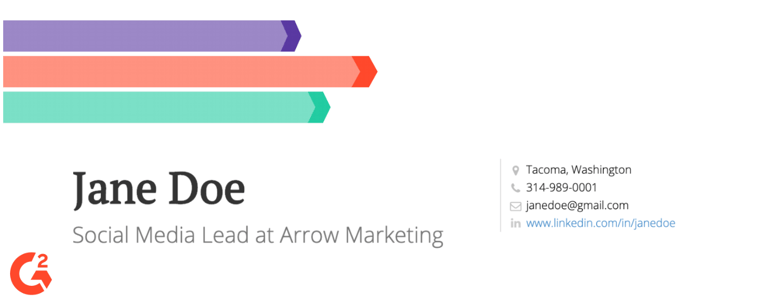
If you work in a field where you would be expected to have an online portfolio of your work (writer, graphic designer, videographer, etc.), you should include a link to your portfolio in this section.
| Tip: Applying for a job out of state? Simply put “Relocating to desired city” in place of your current city and state. |
You don’t need to include your personal home address in your contact section. Your future employer doesn’t have any reason to know exactly where you live.
______________________
Personal / Resume Summary
After your contact information, your personal summary, also known as your resume summary, should be next. This section of your resume is a bite-sized overview of who you are as a professional. You don’t need a resume objective if you plan on using a personal summary. Having both on your resume will take up space and can seem redundant.
How to write a resume summary
- Introduce yourself and what you do
- Talk about the industry you’re in and what your speciality is
- Talk about what inspires your work
Your resume summary should be written in the first person and no more than a paragraph long. A hiring manager isn’t going to read through more than a couple short sentences in this section, so you want to pack a lot of punch into a small section.
Resume summary example
Here’s a quick example of a resume summary you can use for inspiration:
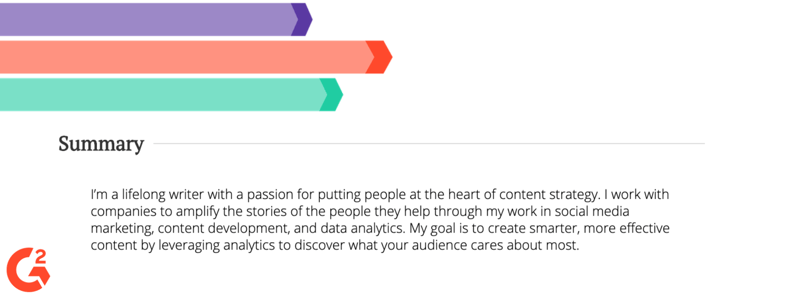
This example is both personable and professional. You get a little bit of personality from the writer while knowing exactly who they are, what they do, and why they love doing it.
______________________
Skills and Certifications
Your skills and certifications section is a little more flexible than other sections of your resume. It doesn’t matter if you list it before or after your work experience. Ultimately that comes down to personal preference.
What should you list under skills and certifications?
- Industry or job specific software you’re proficient in (Adobe Suite, Sales software, etc.)
- Job related certifications you’ve earned (Google Analytics, Hubspot certifications, etc.)
- Technical skills that not everyone can do (Video editing, photography, etc.)
You can skip including that you’re cooperative, a team-player, or a good listener on your skills section. Employers expect you to be all of those things and more. This is where you need to set yourself apart from other people applying for the job by focusing on tangible, hard skills.
Skills and certifications example
Here’s a quick example of an education summary you can use for inspiration:

Your skills and certifications section should be a quick, bullet point list. You do not need to dive into any details here. Just list them out.
______________________
Work Experience
This section of your resume will make up the bulk of your resume. This is where hiring managers are going to spend the most time looking, so you want to make sure you get this part right.
A common mistake people make when writing their resume is listing every job they’ve ever had. Your resume is not a legal binding document. You are allowed to pick and choose which jobs you include. Did you have a job that you hated and your boss was awful to you? Unless it’s the perfect job to include on your resume, you can skip it!
What to include in your work experience summary
- Job Title
- Company Name
- Time at company
- 3 – 5 job descriptive details
If you received a promotion or any notable awards in any of your previous positions, this is the section you would include those things.
| Tip: You can denote a promotion by listing your first bullet point to say something like: “Started as a social media specialist in June 2016, promoted to team lead in April of 2018.” |
If you have been promoted in a previous position, you should focus your work summary on the job details for your most current position. A hiring manager wants to know what you worked on most recently at any company, not what you did three years ago.
Tips for writing a work experience summary
- Only list relevant positions
- Keep your summaries to three to five bullet points
- Avoid fluff and industry buzzwords
- Quantify everything you can with data
- Use action verbs to sound more authoritative
Work experience summary example
Here’s a quick example of a work experience summary you can use for inspiration:
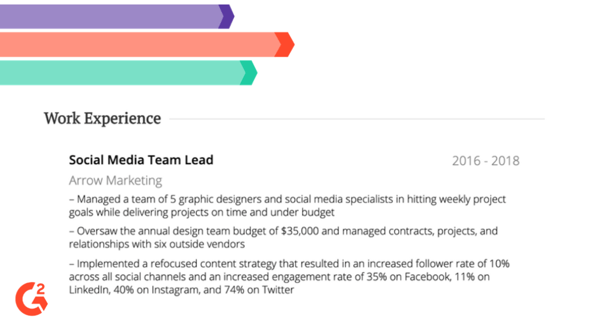
Each of these examples includes an action verb, quantifiable data, and gets directly to the point of the impact made in that position.
____________________________
Education
The biggest mistake people make on their resume is putting their education at the top of their resume. Unless you’re currently in college or have just graduated, your education section should be at the very bottom of your resume.
What to include in your education summary
- Name of your school
- Years of attendance
- Degree acquired
- Any relevant honors
You don’t need to include your GPA on your resume, especially if you’re more than a year out of college. There are some exceptions to the rule, but unless you attended a prestigious university or have a Masters or Doctorate level degree, the education section matters less and less as you advance in your career.
Education summary example
Here’s a quick example of an education summary you can use for inspiration:
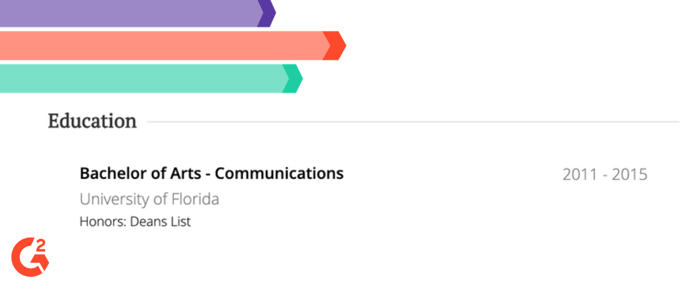
This section is important to show hiring managers that you attended school and meet their basic education requirements but that’s it. Don’t feel pressured to add fluff to this section of your resume. Keep it simple!
________________________________
3 Main Types of Resume
Now that you know what you should include in your resume, it’s time to decide on the best format for your resume. There are three main types of resumes that you can choose from when crafting the perfect resume.
1. Reverse-chronological
The reserve-chronological resume is probably the one you’re most familiar with seeing. It lists your work experience from most recent to least recent. This resume is perfect if you’ve been in the same field your entire career and have a linear career path.
Here’s an example of a reverse-chronological resume:

You should avoid using this resume if you have gaps in your work experience or if you’ve switched career paths. There are better options listed below for anyone with a less linear career experience.
2. Functional resume
The functional resume focuses more on your skills and less on your career experience. This resume is perfect for those who have jumped around in their career or taken a significant time off from working and are looking to reenter the workforce.
Here’s an example of a functional resume:

The functional resume will allow you to highlight the best parts of your professional experience without having to explain gaps in your work experience or frequent career jumps.
3. Combination resume
If neither of the above resume styles seem to suit your needs, the combination resume might be perfect for you. This resume format spends the first half covering your skills and qualifications, while using the second half to highlight your most relevant career experience.
Here’s an example of a combination resume:
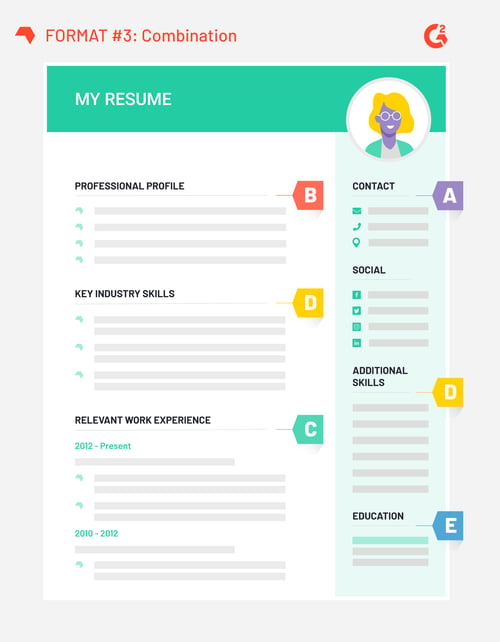
You shouldn’t use this resume if you’re an entry level candidate because you likely won’t have the necessary experience or skills to fill the entire resume. This is for more experienced candidates who are looking to move deeper into their career.
__________________________________
5 Fast Tips for Resume Writing Success
Along with the technical aspect of actually writing your resume comes the unspoken rules that recruiters and hiring managers expect jobseekers to already know. These quick tips will help you edge out the competition and stand out from a crowd of qualified candidates.
1. You should tailor your resume for each new job
Yes, you should be tweaking your resume before each and every job application. The painful truth is that generic resumes are immediately eliminated by 18 percent of hiring managers. [CareerBuilder]
Do yourself a favor and spend ten minutes making adjustments to your resume to fit the job you’re applying to before you send it out. It could mean the difference between a first round interview and your application ending up in the trash.
2. Do your keyword research before you submit your resume
Technology is playing a larger part in recruiting and hiring than ever before, and jobseekers need to be prepared to work with it. Half of all candidates are eliminated from the online job search by applicant tracking systems. [TopResume]
This means you should be doing your keyword search on the job you’re applying for and finding what these programs are looking for when they scan resumes. You should be packing your resume full of relevant keywords (where it’s appropriate) to help increase your chances of having your resume screened positively by an ATS.
3. Don’t lie on your resume, chances are you’ll get caught
A survey conducted by CareerBuilder found that 75 percent of human resource managers (those who typically review resumes before passing on to a hiring manager) have caught a lie on a resume.
If you get caught in a lie by an HR manager you can expect your resume to get tossed right in the trash. Getting a job is already hard enough without adding the complication of keeping track of little white lies and fibs you’ve told on your resume and during the interview process. Just don’t do it.
4. You DO need a cover letter with your resume
The great debate around whether or not you really need a cover letter may be waging on, but 1 in 10 hiring managers won’t bother reading your resume without one according to that same Careerbuilder survey.
You may like those odds, but if you want to maximize your chances of having your resume read then you should include a cover letter with your resume.
5. Keep your resume to one page
Unless you’re twenty years into your career or applying for a C-Suite level job, you need to keep your resume to one page. According to Careerbuilder, a resume that’s longer than two pages is a deal-breaker for 17 percent of hiring managers.
That same survey from Careerbuilder mentions that 2 in 5 hiring managers spend less than a minute looking at a resume, and 1 in 4 spend less than 30 seconds. That means you don’t need more than a page on your resume because the hiring manager isn’t going to read it. Save yourself the time and trouble – keep your resume to a single page.
Remember, writing a great resume is just the first step
While writing a killer resume won’t land you your dream job, it’s the most important tool you have to grab the attention of a hiring manager. Spend the time crafting the perfect resume that shows potential employers why you’re the best fit for the job.
Before you apply for that job, learn how to write a cover letter that pairs perfectly with your new resume.












